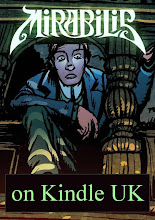 Outside the games industry, interactivity is often met with fascination and fear, and it’s never long before somebody asks, “Will the reader be able to choose the ending?”
Outside the games industry, interactivity is often met with fascination and fear, and it’s never long before somebody asks, “Will the reader be able to choose the ending?”Would you want to? A good story is meant to surprise and delight. If you could bring yourself to pause the action just before Holmes grapples Moriarty, and decide who will go off the ledge, you can’t have been that enthralled. And how would that kind of interactivity enhance your enjoyment anyway? If complete control of the plot is what you’re looking for, the solution is simple: become a writer.
Instead of choosing the ending, then, maybe good interactivity should allow you to influence the ending. There’s something to be said for that. Literary academics are fond of psychoanalysing characters, and it’s a small step from there to giving them advice. “Hamlet, get off your arse, mate.” Of course, characters in a story – just like your friends – don’t have to take your advice. Or how about this: they could misapply your advice and then blame you. Now it’s getting interesting.
The kids’ gamebooks of thirty-odd years ago all followed the obvious model of an omniscient narrator presenting you, in the role of protagonist, with limited information: “Here are three caskets, of lead, silver and gold.” Characterization of the main character is difficult because hearing your avatar talk about things that you as reader know nothing about can really mess with suspension of disbelief. The interactivity inevitably reduces to problem-solving. And I like problem-solving, but it’s not really what’s interesting about fiction.
A more fruitful kind of interactivity is to have a first person narrator with whom the reader can have a dialogue. You’re his Hopkirk, his Harvey, his Tyler Durden. That’s the approach I’ve taken with Frankenstein. In five of the book’s six parts, you are the voice of Victor Frankenstein’s conscience – or ambition, or reason, as you prefer. The effect is very different from a game. It’s like reading the novel. But where, in the original, Victor’s self-pitying introspection can become wearying, here you have the opportunity to challenge him. In striking up a dialogue – a relationship, in fact – you become more invested in his fate. You’re not solving the problems of the plot so much as exploring the crannies of character.
For that reason, perhaps, Michael Bhaskar, my editor at Profile Books, said he found that reconfiguring the text to make it explorable like this makes for a more engaging read than the original. Modern readers, some of whom even struggle with the genius of Dickens, can certainly be forgiven for not wanting to wade through the teenaged Mrs Shelley's stodgy prose. I certainly feel making Frankenstein interactive is a worthwhile experiment, and it opens up other rewarding forms of interactive fiction that are a far cry from, “You see a bloodthirsty ogre at the end of the passage.”
I don’t think this is the future of books, though. The novel as a form does not require fixing. Never, when reading War and Peace, did I wish I could break out of the story to call up a map of a battlefield or research 19th century Russian etiquette. Sometimes I might grudgingly refer to the notes at the back, resenting the interruption of the narrative flow even as I did. If it’s a good novel, I don’t want it to have pictures or sound effects or 3D. It doesn’t need them. A great story holds you spellbound in the world of your imagination. Or rather, and better, in the fusion of your imagination with the author’s.
Which is, when you think about it, a truly rewarding form of interactivity. And it’s been there all along.
Frankenstein is coded for iPad and iPhone by Inkle and published by Profile Books.























No comments:
Post a Comment